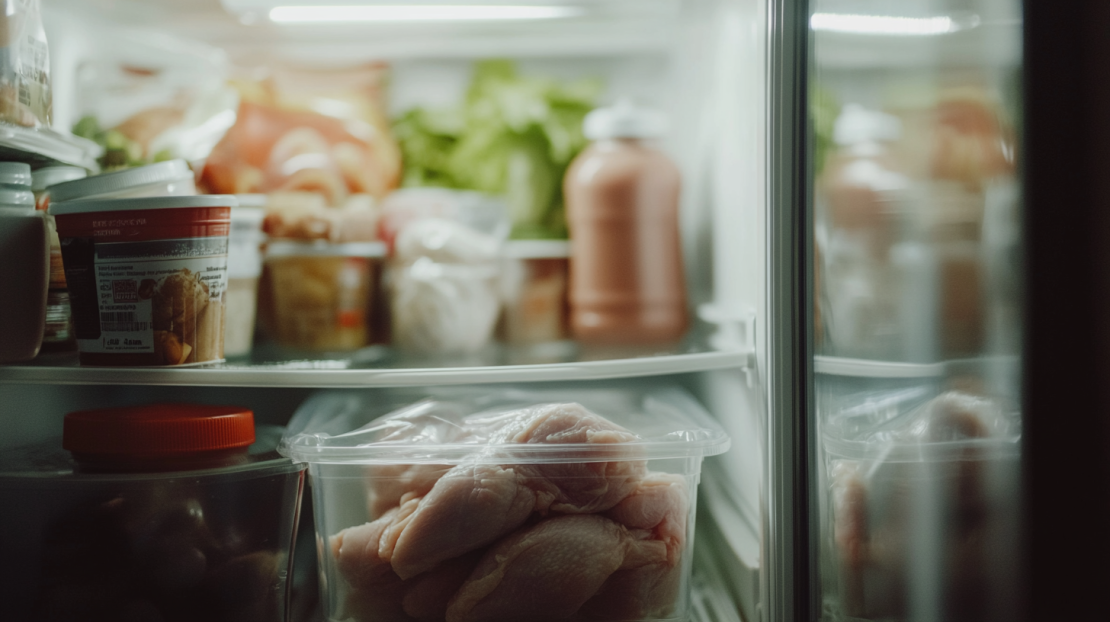How to Properly Store Raw and Cooked Chicken for Ultimate Freshness and Safety
Storing chicken might seem straightforward, but one wrong step can lead to spoiled meat, wasted money, and worse – food poisoning.
Whether raw or cooked, chicken requires careful storage to maintain its quality, freshness, and safety.
This guide offers you every essential tip for storing raw and cooked chicken, from where it should go in the fridge to how long it’ll keep in the freezer. Let’s make sure your next chicken dinner stays fresh, tasty, and safe!
The Essentials of Chicken Storage Guidelines
It’s important to store chicken right. This means knowing the right temperatures and signs of freshness. By doing this, you make sure your chicken is fresh and safe to eat from farm to table.
Understanding the “Danger Zone” for Chicken
The “Danger Zone” is when temperatures are between 40°F and 140°F.
This is where bad bacteria grow fast.
You must get chicken below 70 degrees within 2 hours of cooking and below 40 degrees withing 4 hours of that. This will ensure you stop bacteria.
Identifying Freshness and Expiration Dates
Checking chicken for freshness and ‘use by’ dates is also key.
Fresh chicken looks the same all over, feels a certain way, and doesn’t smell bad.
Always use or freeze chicken before it expires. Cooked chicken leftovers should be eaten within three to four days if kept in the fridge at 40°F or less to keep it fresh.
Table Of Chicken Storage Guidelines
| Storage Type | Location | Temperature | Duration | Best Practices |
|---|---|---|---|---|
| Raw Chicken | Fridge (Bottom Shelf) | ≤ 40°F (4°C) | 1-2 Days | Keep in airtight container to avoid cross-contamination |
| Raw Chicken | Freezer | ≤ 0°F (-18°C) | Up to 9 Months | Wrap tightly in plastic and use freezer bags to prevent freezer burn |
| Cooked Chicken | Fridge | ≤ 40°F (4°C) | 3-4 Days | Store in sealed container and consume promptly |
| Cooked Chicken | Freezer | ≤ 0°F (-18°C) | Up to 4 Months | Wrap well and label with date for best quality |
| Thawing (Fridge) | Fridge | ≤ 40°F (4°C) | 24 Hours | Allow chicken to thaw overnight in a shallow container |
| Thawing (Cold Water) | Sink | Cold Water | 30 mins – 1 hr | Change water every 30 mins; cook immediately |
| Thawing (Microwave) | Microwave | Defrost Setting | 10-15 mins | Cook immediately after thawing |
How To Store Raw Chicken In The Fridge
Keeping raw chicken fresh and free from contamination starts the minute you bring it home from the grocery store.
1. Fridge Placement Matters
Raw chicken is highly perishable, so it needs to be kept cold – ideally at 40°F (4°C) or lower. Store it on the bottom shelf, in the back where your refrigerator stays the coldest. This placement also prevents chicken juices from potentially leaking onto other foods and causing cross-contamination.
2. Choose the Right Container
Keeping raw chicken in an airtight container or well-wrapped in plastic is essential. Plastic containers with lids or resealable plastic bags can prevent the chicken’s moisture from evaporating and keep it from absorbing other flavors and odors in the fridge.
3. Shelf Life for Raw Chicken
Once raw chicken is in your fridge, plan to cook it within 1-2 days. If you know you won’t use it that quickly, freezing is your best option to maintain its quality. Fresh chicken has a short fridge life, so don’t risk it sitting too long.
4. Raw Chicken Smell and Appearance
If your chicken has a slightly sweet or sour odor, a sticky texture, or a grayish color, it’s likely spoiled and should be discarded. Fresh raw chicken should have a mild smell and a light pink color.
How To Freeze Raw Chicken At Home

If you’re not planning to use your chicken within two days, freezing it can keep it safe for months.
1. Prep for Freezing
Before freezing raw chicken, wrap each piece individually in plastic wrap or butcher paper. After wrapping, place the pieces in freezer-safe bags, pushing out as much air as possible to prevent freezer burn.
2. Shelf Life of Frozen Chicken
When properly stored, frozen raw chicken can keep for 6-9 months without sacrificing much quality. Whole chickens and larger cuts of chicken typically stay fresher longer than smaller cuts like tenders or pieces, which may only last up to six months in the freezer.
3. Freezer Placement for Best Results
Store your chicken in the coldest part of the freezer, ideally in a chest freezer or deep freezer that maintains consistent temperatures. This can help prevent temperature fluctuations that lead to freezer burn.
4. How to Thaw Frozen Chicken Safely
The safest way to thaw frozen chicken is by placing it in the fridge for 24 hours. This method prevents it from entering the temperature “danger zone,” where bacteria multiply quickly. In a rush? Use cold water to thaw, ensuring you change the water every 30 minutes, or use your microwave’s defrost setting, but be ready to cook it immediately after thawing to prevent any bacterial growth.
Storing Cooked Chicken To Keep Leftovers Safe and Delicious
Cooked chicken leftovers can be a lifesaver on busy days, but storing them safely is crucial for quality and safety.
1. How to Store Cooked Chicken
For best results, refrigerate cooked chicken within two hours of cooking. Use an airtight container to help retain moisture and keep flavors intact. Make sure the container seals well to prevent the chicken from drying out.
2. Fridge Shelf Life of Cooked Chicken
Cooked chicken stays fresh in the fridge for 3-4 days. If you won’t use it within that timeframe, consider freezing it to extend its shelf life.
3. Freezing Cooked Chicken
Cooked chicken can last up to 4 months in the freezer. Follow the same process as with raw chicken: wrap pieces tightly, place them in freezer-safe bags, and label with the freezing date.
4. Reheating Frozen Cooked Chicken
For the best flavor and texture, thaw frozen cooked chicken in the fridge overnight. Reheat it in the oven, stove, or microwave, ensuring it reaches an internal temperature of 165°F (74°C) to make it safe for consumption.
Avoiding Common Mistakes in Chicken Storage
Mistakes in storing chicken can lead to flavor loss, spoilage, and worse – foodborne illness. Here’s what not to do.
1. Never Leave Chicken Uncovered in the Fridge
Leaving chicken uncovered is a quick way to dry it out and contaminate other foods. Always cover your chicken, whether raw or cooked, to maintain its moisture and keep it safe.
2. Skipping the Airtight Container
While it might seem overkill, airtight containers prevent freezer burn, which can ruin the taste and texture of your chicken. A tightly wrapped piece of chicken in an airtight bag keeps flavors intact.
3. Forgetting to Label Frozen Chicken
When freezing chicken, always label with the date and type (e.g., “cooked breast,” “raw thighs”). This helps you track what you have and know when it’s still safe to eat.
4. Thawing Chicken at Room Temperature
Chicken should never be thawed at room temperature, as this allows bacteria to grow quickly. Stick to fridge or cold water methods, or defrost using the microwave if you’re in a hurry.
How to Tell If Chicken Has Gone Bad
Eating spoiled chicken is dangerous, so knowing the signs of spoilage is crucial.
1. Smell
Raw or cooked chicken that has gone bad often smells sour, musty, or off. Trust your nose – if it doesn’t smell like fresh poultry, it’s likely spoiled.
2. Texture
Spoiled chicken usually has a slimy or sticky texture, regardless of whether it’s raw or cooked. Fresh chicken, on the other hand, should feel smooth to the touch.
3. Color
Fresh raw chicken should be pale pink. If it turns gray, brown, or has patches of discoloration, it’s no longer safe. Cooked chicken that develops a dull or grayish color is also best discarded.
Storing Tips for Busy Households And How To Maximize The Freshness Of Your Chicken
With a few extra tips, storing chicken can be easy and foolproof.
1. Separate Raw from Cooked Chicken in the Fridge
Storing cooked and raw chicken in separate containers on different shelves will prevent cross-contamination and improve food safety. Never Store these raw and cooked chicken together or on the same shelf. Bottom shelf only for raw poultry my friends!
2. Invest in Quality Freezer Bags
Quality freezer bags or vacuum sealers prevent freezer burn by keeping air out, ensuring your chicken maintains its quality longer.
3. Opt for Smaller Portions
If you plan on storing a lot of chicken, consider portioning it into smaller meal-size servings. This way, you only thaw what you need, reducing waste and keeping leftovers fresh.
4. Be Mindful of Freezer Temperature Fluctuations
Keep your freezer at a stable 0°F (-18°C) to keep all meats safe. Frequent temperature changes in your freezer can cause freezer burn and shorten the shelf life of your chicken.
FAQs on How to Properly Store Raw and Cooked Chicken
Raw chicken should ideally be used within 1-2 days of refrigeration. If you can’t use it within this period, freeze it for long-term storage.
Yes, but only if it was thawed in the refrigerator. Refreezing chicken thawed at room temperature or in water is unsafe.
Wrap each piece tightly in plastic wrap, then place on a sheet pan in the freezer to rapid freeze. Once frozen, remove from the sheet pan and transfer to a freezer safe bag. Remove as much air as possible and return to the freezer. This method helps preserve moisture and prevent freezer burn.
Freezer burn happens when food isn’t well-sealed. Wrap chicken tightly, remove all air from bags, and use quality freezer storage bags to keep it fresh.
Properly stored, cooked chicken is good for 3-4 days in the fridge. Any leftovers beyond that should be discarded or frozen for longer storage.
No, leaving chicken uncovered will cause it to dry out quickly and may contaminate other foods with bacteria from raw poultry.
Signs of spoilage include sour or unusual odors, a sticky texture, and discoloration. If in doubt, it’s safest to discard the chicken.
Final Thoughts
Understanding how to properly store both raw and cooked chicken is a game-changer for your meals.
Not only does it keep your chicken safe and delicious, but it also cuts down on food waste.
Once you’ve got the hang of these storage tips, you’ll wonder how you ever managed without them.
Disclosure: This article uses automation for structure, but all insights and advice are provided by Ryan Yates, an experienced executive chef with over 20 years of expertise. Additionally, this post may contain affiliate links, which means we may earn a small commission if you purchase through them, at no extra cost to you. This helps support our work and allows us to keep providing high-quality content.


